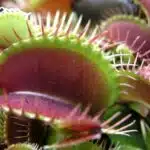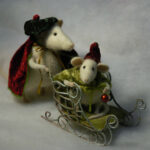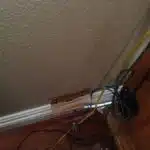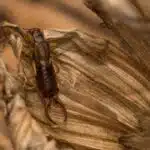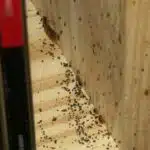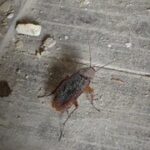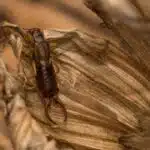Dealing with chipmunks can be a frustrating and time-consuming task for homeowners. These small rodents can cause significant damage to lawns, gardens, and homes by digging holes and burrows. Additionally, they are notorious for stealing birdseed and other food sources. To address these issues, many homeowners turn to traps or repellants as a means of removing or deterring chipmunks from their property.
When it comes to trapping or repelling chipmunks, there are several different methods that can be employed. Each method has its own unique advantages and disadvantages, but ultimately the best approach will depend on the specific circumstances of the infestation. In this article, we will explore some of the most effective ways to get rid of chipmunks using traps or repellants. By following these tips and techniques, homeowners can successfully manage their chipmunk problem and protect their property from further damage.
Identifying Signs Of A Chipmunk Infestation
An infestation of chipmunks can cause serious damage to your yard and garden. These small rodents can quickly become a nuisance, burrowing holes in the ground and chewing on plants. To effectively combat a chipmunk infestation, it is important to first identify the signs of their presence.
Chipmunks are known for their nesting habits, which include digging tunnels underground and building nests out of leaves and grass. They are primarily active during the day and prefer to live in areas with plenty of cover, such as under bushes or in piles of rocks. Chipmunks have a varied diet that includes nuts, seeds, fruits, and insects.
If you suspect that you have a chipmunk infestation, look for signs of damage around your property. Chewed plants and burrow holes are two key indicators that these rodents are present. Chipmunks will often dig multiple tunnels throughout an area, creating extensive networks that can be difficult to eradicate without professional help.
Understanding Chipmunk Behavior
To effectively control chipmunk populations, it is important to have a basic understanding of their behavior. One key element of chipmunk behavior is territoriality. Chipmunks are known for defending their territories fiercely against other chipmunks and even other small animals. They mark their territories using scent glands and vocalizations, which helps them avoid unnecessary conflict with other chipmunks.
Another important aspect of chipmunk behavior is communication. Chipmunks use a variety of vocalizations and body language to communicate with each other. For example, they may use high-pitched chirps to signal danger or alarm calls to warn others about potential threats. They also use tail movements and postures as visual signals to communicate with each other.
By understanding these behaviors, homeowners can better understand how to control chipmunk populations in their yards. By disrupting their territorial markings or using repellents that mimic predator scents, homeowners can make the area less attractive to chipmunks. Additionally, choosing the right type of trap or repellent can be effective in reducing the number of chipmunks in the area. In the following section, we will discuss some strategies for selecting the best traps and repellents for controlling these pests in your yard.
Choosing The Right Trap Or Repellent
When it comes to dealing with chipmunks, using traps and repellents are two effective methods for pest control. However, choosing the right trap or repellent can make all the difference in catching or deterring these pesky rodents. Here are some tips on how to choose the right method for your situation.
Trap baiting is an important factor when choosing a trap. Chipmunks are attracted to nuts, seeds, and fruits and will be more likely to enter a trap that contains these types of bait. Peanut butter is also a popular option as it is sticky and has a strong smell that will attract chipmunks. When setting up your traps, be sure to place them in areas where you have noticed chipmunk activity such as near burrows or along pathways they tend to use.
Repellent application is another method of controlling chipmunk populations. There are several types of repellents available such as granules, sprays, and electronic devices that emit ultrasonic sound waves. Granules should be spread around areas where chipmunks frequent while sprays can be applied directly onto surfaces such as plants or garden beds. Electronic devices should be placed near entry points such as doors or windows to deter chipmunks from entering your home.
Choosing the right trap or repellent will depend on your individual circumstances such as the severity of the infestation and whether you prefer live trapping or lethal trapping methods. In the next section, we will discuss the differences between live traps vs. lethal traps and which one may be best suited for your needs. By following these tips on trap baiting and repellent application, you can effectively control the chipmunk population in your area without causing harm to yourself or others.
Live Traps Vs. Lethal Traps
When it comes to getting rid of chipmunks, there are two main types of traps available: live traps and lethal traps. Live traps capture the animal without harming it, allowing for humane relocation to a different area. Lethal traps, on the other hand, kill the chipmunk upon capture. While both types can be effective in reducing a chipmunk population, many people prefer live traps due to their humane methods.
Live traps work by luring the chipmunk into an enclosed space where they cannot escape. These traps typically use bait such as seeds or nuts to attract the animal. Once inside, a door closes behind them, trapping them until they can be released elsewhere. It is important to check live traps frequently as trapped animals can become stressed or dehydrated if left for too long.
Lethal traps, also known as kill traps, are designed to kill the chipmunk upon capture. These types of traps come in various forms such as snap traps or poison baits. While lethal methods may seem more efficient at first glance, they pose a risk to not only the targeted animals but also other wildlife in the area that may accidentally come into contact with them. In addition, lethal methods go against humane principles and values that emphasize minimizing animal suffering whenever possible.
| Trap Type | Pros | Cons |
|---|---|---|
| Live Traps | Humane method that allows for relocation of captured animals | Requires frequent monitoring and release of trapped animals |
| Lethal Traps | Quick and efficient at reducing a population | Poses risks to non-targeted wildlife and goes against humane principles |
Transition:
While choosing between live and lethal trap options is important, ensuring the effectiveness of your chosen method is equally crucial. One way to increase your chances of success is through proper baiting techniques.
Baiting Traps For Maximum Effectiveness
To effectively trap chipmunks, it is important to use the right bait. Different types of bait can be used including seeds, nuts, fruits, and peanut butter. Chipmunks are known to have a sweet tooth, so using sweet baits such as sunflower seeds or raisins can increase the chances of trapping them. It is also important to change the bait often to keep it fresh and appealing.
Placing traps in areas where chipmunks are active is crucial for success. These areas can include near burrow entrances, under bushes or shrubs, or along walls of buildings. Before setting the trap, it is important to ensure that the area is free from any potential obstructions that could interfere with the trap’s function. Traps should also be placed in an area where pets or children cannot access them.
To maximize effectiveness when trapping chipmunks, there are several additional factors to consider:
- Use multiple traps: Placing more than one trap ensures greater coverage and increases the likelihood of catching chipmunks.
- Use different baits: Chipmunks may prefer different types of food depending on their location and time of year.
- Check traps regularly: To prevent unnecessary suffering of trapped animals and ensure maximum effectiveness, check traps at least once per day.
- Choose the right type of trap: There are several types of traps available including snap traps and live cages. Choosing the appropriate type for your needs is essential.
- Safely release trapped animals: When releasing trapped animals back into the wild, choose a location at least five miles away from your home to prevent them from returning.
Proper placement of traps is just as important as using effective bait when trapping chipmunks. In the next section we will discuss how to properly place traps for optimal results.
Proper Placement Of Traps
Just as a skilled angler selects the right lure to catch a specific type of fish, an expert trapper considers multiple factors when selecting bait for chipmunks. When trapping chipmunks, it is important to use the right bait to attract them to the trap. Some effective baits include peanut butter, birdseed, and sunflower seeds. Chipmunks are particularly fond of nuts and seeds, so these types of baits often work well.
Trapping techniques vary depending on the type of trap used. Live traps are a humane option that allows for the safe capture and relocation of chipmunks. Snap traps or glue boards can also be effective but may result in injury or death to the animal. When using snap traps or glue boards, it is important to check them frequently to prevent unnecessary suffering.
Proper placement of traps is vital for successful trapping. Chipmunks are active during the day and prefer areas with access to food sources such as gardens or bird feeders. Placing traps near these areas can increase the chances of catching a chipmunk. It is also important to place traps where they will not be disturbed by children or pets.
Checking and disposing of trapped chipmunks must be done carefully and humanely. Live-trapped chipmunks should be released in a suitable habitat away from homes and buildings. Injured or dead animals should be disposed of properly to prevent contamination and disease spread. Regularly cleaning and disinfecting traps can help prevent the spread of disease and ensure continued effectiveness in trapping efforts.
Checking And Disposing Of Trapped Chipmunks
After you have successfully trapped a chipmunk, it is important to handle the disposal process in a humane and efficient manner. There are various disposing methods that you can use, but it is important to always consider the environmental impact of your chosen method. One common method is releasing the chipmunk into the wild, preferably in an area far away from residential areas.
If releasing the chipmunk is not possible, then euthanizing it may be necessary. This should only be done by a professional wildlife control expert who can ensure that the process is done humanely and safely. It is also important to check with local laws and regulations as some states require permits or prohibit certain disposing methods.
No matter which disposing method you choose, it is crucial to properly clean and disinfect all traps after each use to prevent the spread of any diseases or parasites. By following these guidelines, you can effectively dispose of trapped chipmunks while minimizing any negative impact on the environment.
Transition: Now that we have covered different disposing methods for trapped chipmunks, let’s move on to exploring homemade repellent recipes that can help keep them away from your property altogether.
Homemade Repellent Recipes
Homemade Repellent Recipes:
There are several homemade repellent recipes that can be effective in getting rid of chipmunks. The most popular recipe is a mixture of castor oil, cayenne pepper, and water. This mixture is sprayed around the area where chipmunks are present. The strong odor and taste of this mixture discourage chipmunks from entering the area. Another effective recipe is a mixture of peppermint oil and water. This mixture is also sprayed around the affected area and acts as a natural deterrent for chipmunks.
However, it is important to note that homemade repellents may not always be 100% effective in getting rid of chipmunks. It may take several applications before seeing any results, and some chipmunks may still find their way into the area despite using these homemade remedies. Additionally, it is important to take safety precautions when using these repellents as they can be harmful if ingested by pets or children.
If homemade repellents do not work, there are alternative methods to consider such as trapping or calling a professional pest control service. It is important to exhaust all options before resorting to lethal methods as there are humane ways to relocate chipmunks to a more suitable environment.
Transition: While homemade repellents can be an effective solution, commercial repellents have been proven to provide quicker results with less effort. Let’s explore some of these options in the subsequent section about commercial repellents and their effectiveness.
Commercial Repellents And Their Effectiveness
When looking for a solution to get rid of chipmunks, using commercial repellents may seem like an easy and convenient option. However, it is important to know which types of repellents to avoid as they can be harmful to both humans and animals. Repellents that contain toxic chemicals such as mothballs, rat poison, or insecticides are not recommended as they can potentially harm pets or children who come into contact with the treated areas.
Fortunately, there are organic repellent options available that are safe for use in residential areas. Natural ingredients such as peppermint oil, garlic, and hot pepper flakes can deter chipmunks without posing any harm to humans or pets. These natural repellents work by emitting strong scents that mask the smell of food sources and disrupt the chipmunk’s sense of smell.
It is important to note that while commercial repellents may seem like an easy solution, they may not always be effective in getting rid of chipmunks. Some species have learned to adapt to certain types of repellents over time. In addition, some products may only repel chipmunks temporarily before they return again. Therefore, it is recommended to combine natural methods with other control measures such as trapping or exclusion techniques for a more comprehensive approach in managing a chipmunk infestation.
Transition: While commercial repellents may work for some homeowners, others prefer a more natural approach in deterring chipmunks from their property. In the next section, we will discuss effective natural methods for repelling these pesky critters without causing any harm to them or the environment.
Natural Methods For Repelling Chipmunks
One possible output using only three paragraph(s) is:
To dissuade chipmunks from invading your property, there are a variety of natural methods that can be employed. These alternatives to chemical repellents tend to be more environmentally friendly and less dangerous to pets and humans. However, it should be noted that natural repellents are generally not as effective as their chemical counterparts.
Some common natural repellents for chipmunks include deterrents made from hot peppers, garlic, or predator urine. These substances can either be sprayed directly onto surfaces or used in sachets placed around the perimeter of the affected area. While these homemade remedies may provide some level of protection against chipmunks, they often need to be reapplied frequently and may not work for all situations.
For those who prefer a hands-off approach to pest control, it may be best to rely on professional intervention or invest in commercial-grade repellent products. Still, if you’re looking for a cost-effective and environmentally responsible way to deter chipmunks from taking up residence on your property, experimenting with different natural repellents can be a fruitful endeavor.
Moving forward, preventing future infestations will require implementing measures that make your outdoor space less attractive to wildlife. In the next section, we will discuss some practical steps you can take towards achieving this goal without resorting to harmful chemicals or inhumane trapping techniques.
Preventative Measures To Avoid Future Infestations
While trapping and repelling may be effective ways of getting rid of chipmunks, it is also important to implement preventative measures to avoid future infestations. One way to do this is by making landscape modifications. Chipmunks are attracted to areas with dense vegetation, so removing overgrown shrubs and keeping lawns trimmed can help deter them from entering your property. It is also recommended to remove any piles of debris or wood that may serve as a potential nesting site.
Another way to prevent chipmunk infestations is by keeping food sources away. This includes sealing off any cracks or holes in the exterior of your home where they may enter, as well as ensuring that all food sources are properly stored and secured. This means storing pet food indoors and in airtight containers, cleaning up any fallen fruit or birdseed, and not leaving out open garbage cans.
By implementing these landscape modifications and keeping food sources away, you can greatly reduce the likelihood of future chipmunk infestations. However, if you still find yourself dealing with an infestation despite taking these preventative measures, it may be time to consider working with pest control professionals who have the knowledge and tools necessary for safe and effective removal.
Working With Pest Control Professionals
According to a survey conducted by the National Pest Management Association, 45% of homeowners in the United States experience rodent infestations. Whether it’s chipmunks, rats, or squirrels, these pests can cause significant damage to homes and gardens. While DIY methods such as traps and repellants may work for some homeowners, others may require the assistance of pest control professionals.
Hiring professionals for pest control is often the best option for those dealing with persistent infestations that are difficult to manage on their own. Professionals have access to specialized equipment and treatments that are not available over-the-counter. Additionally, they have extensive knowledge and training in identifying the type of rodent infesting a property and determining the most effective treatment plan.
However, for those who prefer to take a hands-on approach, there are DIY alternatives available. Traps can be purchased at most hardware stores or online retailers and come in various types such as snap traps or live-catch traps. Repellents such as peppermint oil or predator urine can also be used to deter rodents from entering certain areas. It’s important to note that while these methods may work for some homeowners, they may not be as effective as professional treatments and could potentially harm non-target animals if not used properly.
Moving forward with pest control requires careful consideration of both DIY alternatives and hiring professionals. Each situation is unique and requires an individualized approach based on the severity of the infestation. In the next section, we will discuss safety precautions when using traps and repellents to ensure both humans and wildlife remain safe during the pest control process.
Safety Precautions When Using Traps And Repellents
- When using any type of trap or repellent to get rid of chipmunks, it is important to wear gloves at all times.
- Traps should always be placed away from areas where children and pets may be, to avoid potential injury.
- It is also important to read, understand and follow all instructions provided on trap and repellent product labels to ensure the proper, safe and effective use.
- It is essential to be familiar with the local laws, regulations, and ordinances regarding trapping, baiting, and use of repellents.
- Traps should be checked regularly and reset if necessary, and any trapped chipmunks should be removed quickly.
- Repellents should be applied in accordance with label instructions and reapplied as needed to maintain effectiveness.
Wear Gloves
As a professional wildlife and pest control expert, it is important to prioritize safety when using traps and repellents. One of the essential safety precautions is to wear gloves when handling these devices. Gloves protect your hands from any potential bites or scratches from the trapped chipmunks, which can carry diseases that are harmful to humans. Additionally, if you use bait in your traps, the scent of human hands may deter chipmunks from approaching it.
When disposing of trapped chipmunks, proper disposal methods must be followed. Wearing gloves during this process helps minimize contact with potentially harmful pathogens that can be found on the animal’s fur and feces. Place the trap and its contents in a garbage bag and tie it securely before disposing of it in an outdoor trash bin. Remember to wash your hands thoroughly after handling the trap to prevent any transmission of disease.
In conclusion, wearing gloves is one safety precaution that should not be overlooked when using traps or repellents for chipmunk control. It protects you from potential harm while also preventing any contamination or transmission of diseases associated with rodent infestations. Proper disposal of trapped chipmunks is equally crucial in keeping both you and your environment safe and healthy.
Place Traps Away From Children
When it comes to using traps and repellents for chipmunk control, it is crucial to prioritize the safety of everyone in the vicinity. One of the essential safety precautions that must be taken is placing traps away from children. This is because curious kids may accidentally interact with the traps, leading to potential harm or injury. As a professional wildlife and pest control expert, it is your responsibility to ensure that all trapping devices are placed securely and out of reach of young children.
To keep children safe, you can use child-safe traps that are specifically designed to prevent accidental injuries. These types of traps have features like enclosed chambers where the trapped animal cannot be accessed by anyone else except for the person handling it. Additionally, alternative repellents like natural oils and sprays can be used instead of traps altogether. These repellents are effective in keeping chipmunks away without posing any safety risks to people or pets.
As a professional wildlife and pest control expert, it is imperative to consider the safety of everyone involved in chipmunk control measures. By placing traps away from children and utilizing child-safe traps or alternative repellents, you can ensure that no one gets hurt while effectively controlling chipmunk infestations. Remember that taking these safety precautions shows your commitment to serving others by providing safe and effective solutions for their pest problems.
Follow Product Instructions
When using traps and repellents for chipmunk control, it is essential to follow product instructions to ensure safe and effective use. One way to gather information on product usage is by reading product reviews from other users. Product reviews can provide insight into the effectiveness of the product and any safety concerns that other users may have encountered.
As a professional wildlife and pest control expert, it is also important to follow expert recommendations when using traps and repellents. This includes using the appropriate type of trap or repellent for the specific pest problem and ensuring that all devices are properly placed and secured. Expert recommendations can be found through industry publications or by consulting with other professionals in the field.
Following product instructions and expert recommendations will not only ensure safe use but also increase the likelihood of successfully controlling chipmunk infestations. By taking these measures, you can provide effective solutions while also prioritizing the safety of everyone involved. Remember to always prioritize safety when dealing with pests, as it shows your dedication to serving others through safe and effective pest control methods.
Legal Considerations For Chipmunk Removal
Obtaining permits is an essential step in chipmunk removal, especially if the animals are protected by state or federal laws. In some states, it is illegal to trap or kill chipmunks without a permit. Before attempting any removal methods, homeowners should contact their local wildlife agency to inquire about necessary permits and regulations.
Ethical considerations for chipmunk removal should also be taken into account. While they may be considered pests by some, chipmunks play an important role in the ecosystem. They help distribute seeds and serve as prey for larger predators. It is important to consider non-lethal methods of removal first, such as habitat modification or exclusion techniques.
When trapping is deemed necessary, humane treatment of wildlife should always be a top priority. Live traps should be checked frequently to avoid prolonged suffering and released promptly into suitable habitats away from residential areas. Lethal traps should only be used as a last resort and must meet specific guidelines to ensure humane euthanasia. As responsible members of our community, it is our duty to maintain ethical standards when dealing with any wildlife species.
Transition: Now that we have addressed the legal and ethical considerations for chipmunk removal, it is time to discuss how to monitor and maintain a chipmunk-free property without causing harm to these cute critters.
Monitoring And Maintaining A Chipmunk-Free Property
Picture a property free from the pesky chipmunks that have been wreaking havoc in your yard. Imagine waking up every morning to a serene and chipmunk-free environment. This can be achieved through consistent monitoring and maintenance of your property. Landscape modifications, coupled with regular inspection, are some of the ways you can achieve this.
Landscape modifications are an integral part of keeping your property chipmunk-free. Chipmunks love hiding in tall grass and bushes; therefore, keeping your lawn trimmed regularly is vital. Use mulch instead of leaving an open dirt patch where they can burrow and hide. Also, remove any piles of debris or woodpiles where they could nest or hide.
It’s important to conduct regular inspections for any signs of chipmunks on your property. Check for any holes around the foundation of your home or garage as these are potential entry points for them. Look out for chewed wires, wood chips, or any other signs of excavation near plants as this could indicate their presence. Regularly check traps to ensure they are in good condition and baited correctly to increase the chances of trapping them effectively without harm before releasing them elsewhere.
Conclusion
In conclusion, getting rid of chipmunks from your property requires careful planning and execution. Identifying signs of infestation, understanding chipmunk behavior, and choosing the right trap or repellent are crucial steps to consider. It’s important to remember that live traps are more humane than lethal traps, but both can be effective depending on the situation. Baiting traps properly is also key to maximum effectiveness.
Working with pest control professionals is highly recommended for those who are inexperienced in handling wildlife. Taking safety precautions when using traps and repellents is also necessary to avoid any accidents or harm to oneself or others. Additionally, it’s important to consider legal regulations and requirements for chipmunk removal in your area.
Remember that maintaining a chipmunk-free property requires ongoing monitoring and maintenance. Don’t let these cute critters fool you – they can cause damage and pose a threat to your home and garden if left unchecked. Take action today to protect your property from a chipmunk invasion! Let us not forget that every life matters, even those of small creatures like chipmunks that may seem insignificant at times. It is our duty as responsible human beings to handle the situation with care while keeping our surroundings safe and sound.
Image Credits
- “baby Chipmunk playing in the yard yesterday!” by Vicki’s Nature (featured)





